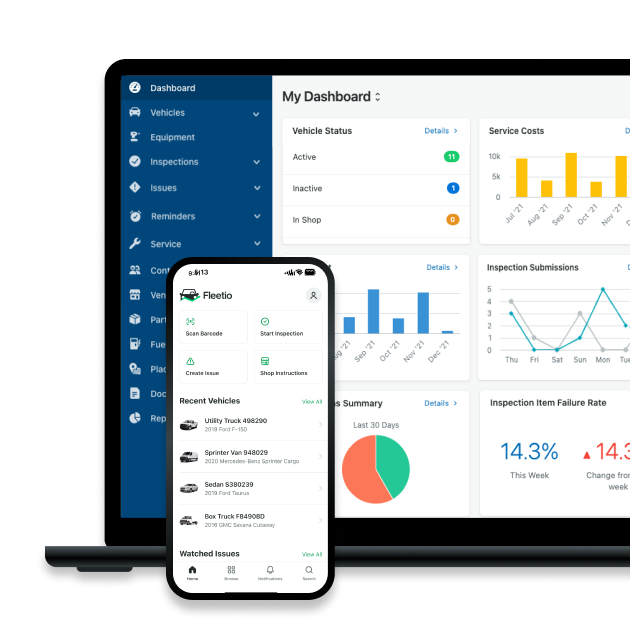Benefits of Leveraging Asset Warranties
Despite the fact that running a fleet is an expensive endeavor, many businesses are not taking full advantage of their assets’ warranties — and it can show in the budget. If you’re not tracking warranty claims separately from maintenance and repairs, it can be hard to see how much money you’re potentially losing. “As a benchmark for a fleet managing assets with a four- to seven-year lifecycle, warranty claims should make up 5 to 8 percent of the total maintenance spend for a fleet,” according to Dave Walters, Senior Solutions Engineer, Trimble Transportation. While this may look like a small amount, it can come out to be several thousands in savings.
Leveraging warranties can also improve fleet safety, as addressing issues covered under warranty ensures assets remain in optimal condition, reducing the risk of accidents or breakdowns on the road. This proactive approach to maintenance promotes driver safety and minimizes the potential for costly downtime and disruptions to operations.
Circling back to those money gains, leveraging warranties can up the resale value of fleet assets. A well-maintained vehicle — especially those with comprehensive warranty and vehicle service histories — is more attractive to potential buyers and can fetch a higher resale price.
Types of Vehicle Warranties
Understanding the value of leveraging these warranties can significantly impact a fleet's bottom line, but not all warranties are created equal. Always be sure to check your assets’ policies and familiarize yourself with what is and is not covered. Different types of vehicle warranties include:
- Manufacturer's warranty: This typically covers defects in materials or workmanship and is provided by the OEM.
- Extended warranty: This is purchased separately from the OEM warranty, extends coverage beyond the original warranty period and may cover additional components.
- Powertrain warranty: This focuses on essential components like the engine, transmission and drivetrain, and offers longer coverage periods but may exclude other parts.
- Bumper-to-bumper warranty: This offers comprehensive coverage for most vehicle components, excluding only wear and tear items like tires and brakes.
Simplifying Warranty Management
Managing fleet warranties manually can be a long, drawn-out hassle — and it's probably a little boring, if we’re being totally honest. Fleets can use fleet management software (FMS) to automate warranty management and ensure clear communication around warrantied services, reducing the chances of overlooking a covered component.
Once an asset’s warranty details are entered into the software — ideally upon procurement — FMS identifies covered services and alerts managers and technicians when a proposed service or component is under warranty, effectively maximizing your warranty benefits while minimizing administrative burdens.
FMS also improves work order accuracy by recording warranty credits recovered from OEMs and suppliers. Fleets can use this information to help benchmark warranty management to ensure they’re reaping the full value of their coverage while reducing unnecessary maintenance and repair spend.
Paying for Warranty Work?
Why spend money you don’t have to? Avoid letting any more warrantied services fly under the radar with warranty management in Fleetio!
Learn moreCoordinating on Warranty Claims
Effective coordination with approved automotive repair shops is essential for maximizing the benefits of fleet warranty policies. Knowing which repair shops are authorized to perform warranty services — and which are in your fleet’s area of operations — can help you craft a strategic plan for handling warranty service smoothly. Partnering with one or two approved shops not only helps ensure warranty repairs are done by qualified technicians using genuine OEM parts, it also allows you a measure of transparency through experience when it comes to potential service delays. Often, establishing ongoing relationships with trusted shops can actually expedite the repair process and minimize downtime.
Fleets can use FMS — and more specifically, Fleetio — to easily coordinate with shops on warranty claims. To ease communication bottlenecks and potential hiccups, fleets can use Fleetio’s Maintenance Provider Network to choose from nearly 100,000 national and independent U.S. shops. Because shops in the provider network use Fleetio’s Maintenance Shop Integration, mechanics are alerted to active vehicle warranty policies. For fleets that primarily service assets in house, technicians are alerted of any applicable warranties directly in digital work orders, allowing for seamless coordination with the OEM or approved repair shop.
Leveraging fleet warranties offers significant benefits, but only by implementing sustainable warranty management strategies can you optimize warranty coverage and maximize the value of your assets.
Seamless Workflows, Endless Opportunities
Seeing Fleetio in action is the only way to truly experience what it can bring to the table.
Schedule custom demo


